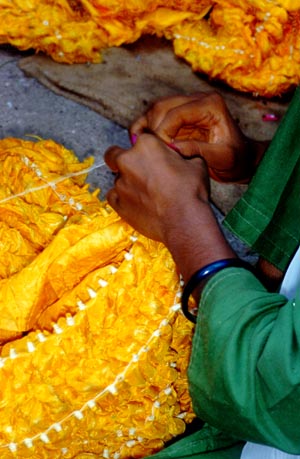INDIA
the hands of an artist, Bhuj, India

hands of an artist in the studio of Khatri Ali Mohamed Isha
Bhuj, Gujerat India
Few craftsmen have such total mastery of their art as Ali Mohamed Isha. Winner of several national awards he carries forward the ancient textile craft of tie-dying.
Cotton cultivation and its use in weaving originated in India. Textile finds from the 3rd millenium BCE have been found at Mahenjo-daro only a few hundred kilometres and 4,000 years from where this photo was taken.
The genes of those ancestors still guide the fingers of the people from Bhuj a small village in the western desert of Gujerat. For many generations the people here have embroidered, printed and dyed cotton and silk.
The technique of tie-dye or bandhani involves binding individual areas of cloth to shield them from the dye. The name comes from the Indian word bandhna , to tie. It is a process which was probably developed in India and taken from there to other regions.
In this photo a shawl of yellow-dyed silk is being tied. Small segments of cloth is bound in sequence to protect them from the next colour of dye to be applied.
The genius of Ali Mohamed is the way in which he combines different colours and patterns, tying them to produce textiles of astonishing freshness and beauty.
Next month: blocking it!
Press the 'Previous' or 'Next' button to see more
If you would like to see just how Ali Mohamed creates such works and experience the vibrancy of Indian craft, join our textile and craft tour later this year.
the 'Warp and Weft of India' Oct - Nov 2000.There are limited spaces for 2000 but we shall run it again in 2002.
Please contact us to go onto our mailing list.or
gain an impression of our Tibet and Nepal treks.return to the photo page from which this account originates.
or site map
revision 18 Mar 2001
http://www.greenkiwi.co.nz/footprints/photo/ph0004.htm